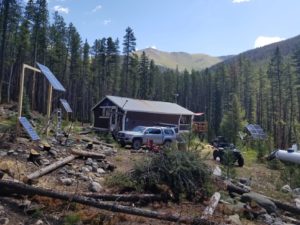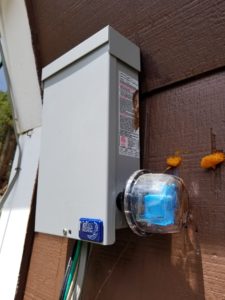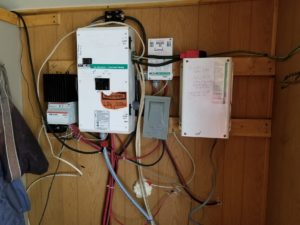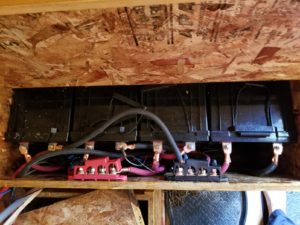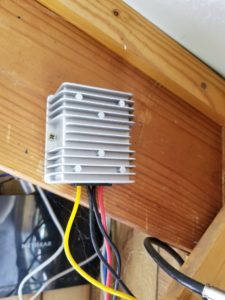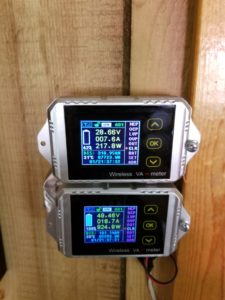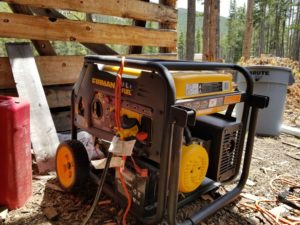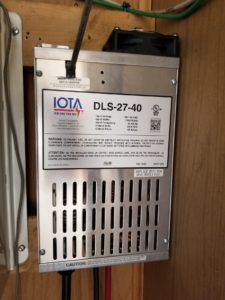Solar Energy
The entire energy for the cabin primarily comes from solar energy. There are no powerlines anywhere near the cabin, so all power needs to be self generated. Currently we have 12 100 watt solar panels giving us a realistic maximum of about 1.1kw of power. Our near term plans include adding an additional 3 170 watt panels (the empty space on the array) so that should add realistically another 500 watts of power. We are constantly balancing between generation and storage capacity.
To keep it all safe, we have a special breaker box outside of the house that is directly grounded to the house ground (a large copper rod in the ground). All of the panels come into this breaker box. Also installed on the breaker box is a lightning arrestor that will shunt high voltages into that ground rod, hopefully keeping it from entering the house. We have a lot of thunderstorms up here, and despite some close strikes, all has still been well.
The Charging and Distribution Center
The central part of our solar system is the charge controller and distribution center. This is setup to convert the solar panel energy into our DC battery voltage. In specific, we are using a Morningstar 60amp MPPT controller.
MPPT controller give a big advantage in charging your batteries. You run your solar array at a higher voltage than your battery voltage, so it then steps down the power to the charge voltage. This gives you more usable power in the early morning, evening, and cloudy days, when the panels are outputting sub optimal voltages. In this case, we have the panels running at 36v (really 58v), and outputting into a 24v (really 29v) battery bank.
Additionally, we have a LVD (low voltage disconnect) inline with the batteries to protect the system if there are multiple days with little energy. It will automatically shut down all loads until the batteries recover above a specific voltage. The system is set to shutdown at 23.5v under load, and reset at above 25v, not under load.
The rest of the components are circuit breakers and cutoffs, to enable safety.
For storage, we currently have 4 12v 200 amp hour batteries giving us 800 amp hours of storage. They are in two banks of two, giving us the 24v battery storage voltage.
In general, the higher the voltage the less loss you have in your wiring with DC. Wire loss over distance is a big issue in DC wiring and you want to use as thick of a wire as you can. For long and high amperage runs, I have utilized welding wire to reduce loss.
Running as a DC Native
One key to maximizing your power is to reduce conversions. A large majority of what we run today is either run by a ‘wall wart’, or is USB powered. This means converting AC power to DC power. When we are already generating DC power, it makes little sense to do this. So throughout the house, all lighting is DC LED based, taking from the RV world. This runs on standard 12v (well 13.8 in a car actually). To achieve this, we step down near the consumption point from the 24v circuit to 13.8v using DC to DC converters that are very efficient.
What this means is I rarely run an inverter in the cabin, and this saves a whole bunch of losses on conversions. I have car USB power supplies to charge/power all of the USB devices and plug those into the converter. I also have specialized DC-DC converters for things like the satellite internet (24v->48v step up converter), or for the computer and LED projector TV (24v->19v DC). These converters are small and affordable, and very efficient.
I also have a specialized refrigerator that runs natively on 24v DC, and has extra insulation for efficiency.
So basically I can run the entire cabin, including the network and my servers, including the fridge, on around 150-250 watts of energy. This is very little in the scheme of things and saves me having to invest in a large amount of panels.
Keeping Track of Everything
The important thing to do is always be monitoring your input and output to make sure you are balancing out your input and output for any given day. These are two inexpensive wireless monitors from amazon.
The top display shows me my current load, and battery bank voltage. As you can see here, I am using 217 watts of power. This is while I was working and have my mini-pc and dual monitors on, and all equipment is up and running.
The bottom display shows me the current voltage of the solar array, and how many watts I am producing. It is full sun out, in the morning, so I am producing 924 watts of energy. All excess energy is added to the battery bank for usage when the sun goes away behind a cloud, or at night.
The Sun Does Not Always Shine
Unfortunately, the sun does not always shine enough to make enough power to meet my needs. As I slowly add more panels, I need less and less sun in any given day, but if we get a bunch of rainy days in a row, I need another way to charge the batteries.
Also, there are high current type items, like our washing machine, that only run briefly and use a lot of power. It makes the most sense in these cases to not rely on the solar system for them.
To do this, we have a dual fuel backup generator that can run on gas or propane. It generates far more power than we need for any of our appliances, but we have a 1200 watt battery charger inline that will charge up our battery banks. So if the sun does not shine on us, we can run that for an hour or two to get things topped back up.

